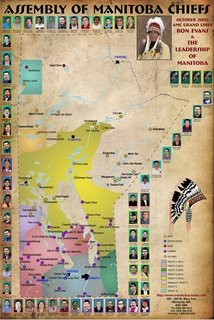
First Nations leaders in Manitoba last week unanimously voted to block rail lines later this month in hopes of pressuring the Canadian government to settle land claims.
Fifty tribal leaders at the Assembly of Manitoba Chiefs supported the blockade. Plans are still being finalized but the First Nations will give advance notice to prevent anyone from being harmed.
The blockade will take place June 29. The Roseau River First Nation plans to block two rail lines coming from the U.S. Several other tribes plan to blockade other lines.
According to Chief Terrence Nelson of Roseau River First Nation, more than 6,000 land claims haven't been settled.
A Press release from Chief Terrence Nelson of Roseau River First Nation, Manitoba reads as follows:Ultimatum meets Ultimatum! As Premier Dalton McGuinty and Minister of Indian Affairs Jim Prentice pull out of the Six Nations/Caledonia land claim with ultimatums that the "barricades must come down," First Nations across Canada are issuing their own ultimatums. Last week, 100 Ontario Chiefs walked to the site of the land claim dispute and issued their own warning to Canada. Today Union of British Columbia Chiefs issued full support to Six Nations. In Manitoba, the Assembly of Manitoba Chiefs, representing 64 First Nations, passed a resolution supporting a 24-hour railway blockade set for June 29th 2006, "to force the Canadian government to establish a reasonable time-frame for settlement of land claims."
Chief Terrance Nelson moved the resolution to "send a message, that resource wealth of our lands are what supports every Canadian." Canada is the third largest producer of diamonds, has 10 per cent of the world's forests, and mines 60 metals and minerals. Oil is now over $72 a barrel, up from $10 a barrel in 1999, and there are 1.4 trillion barrels of oil in the tar sands plus hundreds of other oil and gas producing areas. Canada had eight straight federal government budget surpluses, a 2005 reported net worth of $4.5 trillion, and GDP over a trillion dollars. Today the federal government raises far more revenue from its share of resource royalties than it does from income taxes.
Roseau River will block two railway lines going into the United States. At least six other Manitoba First Nations have vowed to block railway lines at the same time. The financial cost of the railway blockades will be in the millions but the real impact is likely to be the international image of Canada. Canada was the United Nations choice as the "best country in the world to live in" for seven straight years, but while Canada was number one on the index, Canadian First Nations communities mired in extreme poverty were set at the 63rd level on the UN scale. Over 6,000 First Nations land claims are now in limbo.
"What pisses me off when I watch the Caledonia violence" said an angry Chief Nelson, "is the immigrants to our lands didn't bring the diamonds or other resources from Europe in their little wooden boats, yet they have the gall to demand we, the owners of the land and resources, must now pay taxes to them on top of their theft." Treaties 1 to 11 representatives went home last week from a Winnipeg conference to seek support in their regions to initiate railway blockades in traditional territories.
The resolution of the Assembly of Manitoba Chiefs reads:Resolution - Assembly of Manitoba Chiefs
ASSEMBLY OF MANITOBA CHIEFS
SPECIAL CHIEFS ASSEMBLY ON EDUCATION
DAKOTA TIPI FIRST NATION
MAY 30-JUNE 1, 2006
RE: SUPPORT FOR NATIONAL RAILWAY BLOCKADE
WHEREAS, the Roseau River Anishinabe First Nation will initiate a railway blockade on Thursday, June 29th at 4 p.m. and will end on Friday, June 30th at 4 p.m. to force the Canadian government to establish a reasonable time-frame for settlement of land claims; and
WHEREAS, the purpose is to send a message to the federal government and all Canadians that resource wealth of our lands are what supports every Canadian; and
WHEREAS, Roseau River Anishinabe First Nation is asking for other First Nations to support in a national railway blockade to demand an answer from Canada.
THEREFORE BE IT RESOLVED, that the Chiefs-in-Assembly support the one day blockade by the Roseau River Anishinabe First Nation.
Moved by: Chief Terry Nelson, Roseau River Anishinabe First Nation
Seconded By: Chief Morris Shannacappo, Rolling River First Nation
The following is from the CBC.
CN asks court to prevent rail blockades in Manitoba
Canadian National on Thursday sought an injunction in a Manitoba court seeking to block First Nations in the province from blocking its rail lines.
The railway said it filed the application with the Manitoba Court of Queen's Bench.
First Nations leaders in the province said last week they are planning to blockade rail lines this summer to pressure the federal government to settle outstanding land claims.
During a general assembly of the Assembly of Manitoba Chiefs, 50 representatives of First Nations voted unanimously in favour of blocking rail traffic on reserves this summer.
The bands involved plan to block the rail lines for 24 hours on June 29 in southern Manitoba.
"CN has no authority to resolve First Nations' land claims disputes with the federal government, and said rail blockades would be unsafe and unfairly harm CN, its customers and their employees, and the national economy," the company said in a release.
CN Rail also said it has asked First Nations to reconsider their blockade plan and urged them to pursue alternative dispute-resolution mechanisms with the government.



